- Roland G-33 Major Update! 18 new photos, PLUS 4 YouTube videos!
- Switch Roland-Ready MIDI Guitar Complete details on the Switch Wild-IV, PLUS all the Switch Guitars!
- Boss GP-10 and Hex Fuzz Details on great hex fuzz sounds from the Boss GP-10
- Steve Hackett - Roland GR-500/GS-500 Performance - Please Don't Touch From the 'Please Don't Touch' tour, November 8, 1978. Great GR-500 showcase!
- Vintage Roland GR-300 Review from Electronics & Music Maker - Nov 1981
- Roland GR-77B for Reaktor - Download a modeled Roland GR-77B for Native Instruments Reaktor 5!
- Roland GR-700 Blue - Remake with 'GR-300' blue finish, new handles, and handsome natural wood end blocks! Thank you Chuck Nin!
- PG-200 - Updated NOS New-Old-Stock photos of the Roland PG-700, programmer for the Roland GR-700. Thank you Eric Rusack!
- G-707 White Ever wonder what a G-707 would look like redone in a brilliant white finish? With Steinberger folding leg rest!
- 3D Printing Vintage Roland Guitar Parts - 24-to-25 pin Plate - Courtesy of Jusin Casey
- David Gilmour - Solo with Roland STK-1 and GR-700!
- Moog Voyager XL (with Casio MG-510 Cameo) Space Music - Melodic Downtempo, Ambient, Ambient& PsyChill Mix.
- Roland GM-70 Guitar-to-MIDI Converter - Review by Paul White, Music Technology Magazine, April 1987
- Theme from M*A*S*H. Arranged using only the ARP Odyssey for all sounds, synths, drums, efx, etc.
- Ibanez IMG2010 - Owned by George Benson. Rare 'Endorsee' finish with Silver hardware.
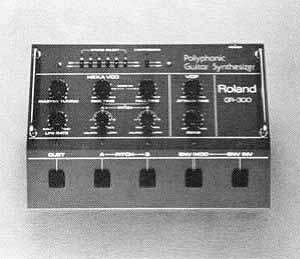
Product Information
Roland Guitar Synthesizers
The Guitar Synthesizer
Throughout the guitar’s colorful history there have been many changes in the design and performance of the instrument. Each change represented a major crossroad for the author of the change and the guitarists of that era. Change never happens without controversy, and at each of the guitar’s changes there were those people who complained that the guitar’s new direction was the wrong one. When steel strings replaced gut strings, when the arch-top was introduced and when the magnetic pick-up was added there were those who could not face the evolutionary progress of the instrument. The same controversy exists today with the guitar synthesizer.
But, as in the past, those people with good ideas and the courage to implement them always prevail. Because of their efforts we have always benefited from that progress.
The Electric Guitar
Looking at the guitar today, it is hard to believe that it has only been electric for some thirty years. With all of the growth of peripheral equipment such as amplifiers, speakers, replacement pickups, effects units and other signal processors to embellish and enlarge its sound, the electric guitar has grown an incredible distance from its humble beginnings.
But the growth of the electric guitar’s possibilities is slowing due to the inherent limitations of the magnetic pick-up. The device that initially set the guitar free is gradually becoming its drawback. The attempts at synthesizing the guitar in the past all had the problem of working with guitar electronics based on the magnetic pick-up.
The Electronic Guitar
When Roland first introduced the GR-500 Guitar Synthesizer System three years ago, we took a different approach from the rest of the entrants into the guitar synthesizer market. Rather than consider the synthesizer as an add-on extra to the guitar, we realized that the electronics in the guitar had to be up to the standard of the synthesizer in order to take maximum advantage of the guitar’s natural abilities of stringbending, vibrato, slurring and other techniques.
The Roland system employed building control electronics into a high quality guitar, to further the control of the synthesizer, as well as achieve high tracking stability. The system worked. That’s why our GR-500 Guitar Synthesizer System was so widely well received, while the others failed.
We also learned from the GR-500 System how to present all the advantages of the electronic guitar, while giving the guitarist all the advantages of the conventional electric guitar at the same time. This led us to the new GR System.
The GR System
The GR Series approach presents the guitarist a number of options-the first of which is the guitar itself. Through the close cooperation of Japan’s most widely respected electric guitar manufacturer, we have produced Guitars of the highest order. The Guitars in the GR Series can easily stand up to any competition on their own merits as electric guitars. The control electronics are conveniently and inconspicuously placed on the instruments so as not to detract from their aesthetic beauty.
The Synthesizer module itself is an independent unit which is placed on the floor for foot-controlled operation. Just as Roland has expanded the line of guitars into other models (such as the new Bass Guitar Synthesizer System), we will eventually expand the synthesizer module system in the future. All modules will use the same interconnection system from the guitar so that the system will not become obsolete.
Therefore, a guitarist can start with the basic GR-300 System and at a later date update his system with some of the new models we will introduce. Some of the planned products include fully programmable synthesizer modules.
The Guitars
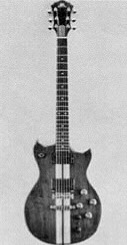 |
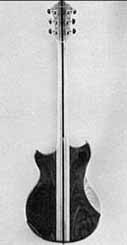 |
|
G-808 |
|
The G-808 Guitar is made for the musician who prefers a neck-thru-body design. The neck-thru-body produces a sweet sustaining quality and the heel of the neck is contoured so access to all 22 frets is easily obtained. The neck is constructed of laminated Maple and Walnut and the fingerboard is made of select Ebony. The body of the G-808 is constructed of laminated Maple and Ash and, to show the beauty of the woods selected, the guitar has a natural finish. All the hardware on the G-808 is gold plated.
The G-303 Guitar was created for the guitarist who prefers the more traditional solid body construction method of a laminated three piece Maple neck set into a body made of laminated Maple and Mahogany. The fingerboard is made of Ebonized Rosewood and all the hardware of the G-303 is chrome-plated with the addition of nickel inserts in the bridge. This particular method of construction has been the most effective for aiding in the production of many of the tonalities used in rock, although the G-303 will find a home equally as well in other forms of music. The G-303 comes in a Mahogany finish.
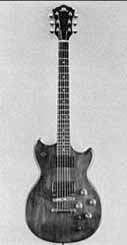 |
|
G-303 |
When using the G-808 or G-303 as normal electric guitars, the guitarist has control of two very clean and powerful humbucking pickups and the tonal characteristics can be changed in a multitude of different ways by a 3 position toggle switch for pickup selection, Master Volume and Master Tone Controls and both instruments are supplied with a 1/4” output jack for connection to any conventional guitar amplifier. Connection to the synthesizer module is accomplished by a 24-pin cable. It is at this point where the G-808 and G-303 Guitars in combination with the GR-300 Polyphonic Synthesizer module becomes vastly different from any normal electric guitar.
On both instruments a special Divided Pickup is used to trigger the Synthesizer Module. This pickup is actually composed of six individual pickups which are highly sensitive to the guitar strings and therefore provide flawless tracking for all synthesizer functions. Guitar techniques now become Guitar Synthesizer technique and the applications of string bending, vibrato, hammering, slurring and harmonics (natural and artificial) are all accomplished by the guitarists hands on the guitar rather than by controlling joy sticks, benders or footpedals as would the keyboard synthesist. And, just as the initial tracking of the guitar strings pitch is excellent, so is the tracking stability. As the strings begin to naturally decay the Synthesizer Module will, without glitching, follow each string with precision and clarity.
The Divided Pickup also produces amazing distortion. Since each string is tracked individually by the pickup the distortion settings, whether for chords or single lines, have a crystal clarity which has never before been obtainable and further distortion tonalities can be achieved by varying the filters. On the Guitar the musician has control of the Voltage Controlled Filters. The VCF Cutoff Frequency Control allows you to tailor the frequency of the VCO and Distortion Modes from soft subtle tones to the bright, harmonically rich timbres of horns and the VCF Resonance Control serves to enhance the tonality by accenting portions of those harmonic structures.
Roland has created a unique application for the use of the Low Frequency Oscillator(LFO) which produces variable vibrato settings. On either side of the pickup is a Touchplate and by simply touching either of these plates you can engage or disengage the LFO. The Touchplate on the topside of the pickup is LFO Latch (On) and the Touchplate on the underside of the pickup is LFO Unlatch (Off), LFO Unlatch also serves as a momentary On which allows greater flexibility of expression for the uses of vibrato. The amount of LFO is highly variable by adjusting the LFO Depth Control.
For greater tonal possibilities, the G-808 and the G-303 Guitars are equipped with a 3 position Voice Selector Switch which allows you to achieve the combinations of VCO VCO+Distortion /Distortion and also a Balance Control which enables you to blend the amount of volume between the direct Guitar signal and the Synthesizer.
Both the G-808 and G-303 Guitars come with a hardshell case which is, for added protection, contoured on the inside to the shape of the instrument.
The GR-300 Synthesizer

The Synthesizer functions are located on a small compact foot-operated unit which allows the guitarist to pre-set desired patches and engage or disengage them by a series of silent FET switches. The unit features a String Select section that lets you predetermine on which strings the Synthesizer will trigger. Any combination on the String Select can be used, such as setting up a bass patch and then activating the patch on String Select number 5 and 6. The Synthesizer patch will operate on the 5th and 6th strings of the guitar only giving you the ability to perform bass lines along with the direct signal of the guitar. Corresponding LED Indicators show on which strings the synthesizer is functioning and a built-in Compression circuit adds greater sustain for the Synthesizer section. An LED Indicator also shows the On /Off status of the Compressor.
In the VCO (Voltage Controlled Oscillator) Section, tuning of all six VCOs is accomplished simultaneously by the Master Tuning Control. LFO Rate (speed of vibrato) is also adjusted in this section and is variable between 2 to 10Hz. The Hexa VCO section also features Pitch A and Pitch B selection which allows you to pre-set any pitch (plus or minus one octave on each control) and instantly switch between the VCO pitch (which coincides with that of the guitar) and the pre-set pitch. This feature gives the guitarist instant transposition capabilities and affords the instrument an incredible range of pitch.
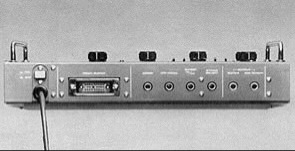
Even greater flexibility is provided because both Pitch A and B feature a Latch /Unlatch Switch. In the Latch position the silent FET switch acts as an On /Off switch and in the Unlatch position it becomes a momentary On switch. Rise and Fall Times can also be pre-set for either Pitch A or B. For example, if Pitch A were set a Perfect 5th above the VCOs you could adjust the amount of time it would take for that pitch to ascend and likewise if Pitch B were set an octave below you could adjust the amount of time for that pitch to descend. The Rise and Fall Times are variable between 0 to 6 seconds.
The GR-300 also has a Duet Switch which combines the fundamental pitches of the guitar strings with that of the VCOs creating a shimmering Chorus effect. But the Duet Switch serves a dual purpose. By setting up a particular pitch on either Pitch A or B the Duet Switch will now function to combine that pitch setting with the VCOs allowing the musician to create huge, orchestral voicings or parallel harmonies for single lines or chords. The Duet Switch is a silent FET switch and has an LED for On /Off Indication.
The next section of the GR-300 is the VCF where controls for Attack Time and Sensitivity are located. The Attack Time determines the amount of time for the VCF to engage and the Sensitivity controls the overall depth of the VCF The VCF section also features an Envelope Modulation switch (ENV MOD) which, when used in conjunction with the VCF controls on the guitar, will create variable ’wow’ effects and with the Envelope Inversion switch (ENV INV) the ’wow’ effect is inverted to an ’ow’ sound. These controls add life and realism to the Synthesizer as when you are working with a brass patch in creating horn section effects.
The outputs on the rear panel of the GR-300 include Mix/Synth which combines the direct signal of the guitar with the Synthesizer or by using the Guitar-Out jack the signals of the guitar and Synthesizer are separated for use with two amplifiers or in a stereo mix situation. Footswitching options for the GR-300 are remote ON /Off for the Compressor, Sweep (Rise and Fall Times) and String Select. With an optional Roland FV-2 Foot Volume Pedal the guitarist can have foot control of the VCF.
The Roland GR-300 Polyphonic Guitar Synthesizer is another product which has been designed to follow the Roland philosophy of Interface and, therefore, is not limited for use as a self-contained unit. On the contrary, the GR-300 can easily be interfaced with all signal processing and effects devices as well as with expandable synthesizer modules such as the Roland SPV-355 Pitch to Voltage Converter. Even when future GR products are made available the GR-300 with either the G-808 or G-303 Guitar will have many interface possibilities.
The Bass Guitar Synthesizer
The electric bassist has always had a willingness to experiment with new inventions, devices and instruments which would lead to the improvement of his technique and sound. Unfortunately, the bassist has really had a limited number of tools to alter his sound in such a way as to be electronically expressive as his peers-the keyboard and guitar synthesist. While even the percussionist has joined the synthesist bandwagon, the bassist has not been able to enjoy the colors and textures available on the synthesizer simply because there had never been a system developed that could accurately track the irregularities of a moving string at the low frequencies (pitches) produced by a bass guitar.
Roland now introduces the G-33B Bass Guitar Synthesizer which not only tracks the lowest note on the Bass Guitar with accuracy and stability but actually tracks well below that pitch (down to 21 Hz). As of this writing the final specifications of the Bass Guitar and Synthesizer Module have not been finalized, however, the basic functions of the Roland G-33B can be explained.
The Bass Guitar
The Bass Guitar functions as a normal bass by itself but has some added features which make it (even without the Synthesizer Module) a most desirable instrument by itself, not merely a second axe. The Bass Guitar features active electronics which enable the player to tailor the sound of the instrument to equal that of many different makes of basses on the market or enhance his own personal sound by cutting or boosting the amounts of Bass and Treble which are controlled on the instrument.
The Bass Guitar Synthesizer also has many of the functions for the control of the Synthesizer Module built into the body. Controls for the VCF (Voltage Controlled Filter) Cutoff Frequency and Resonance which serve to adjust the synthesizer sounds from soft tonalities to harmonically rich colors are within easy reach of the players hands. The Low Frequency Oscillator (which gives variable vibrato effects) Controls are LFO Latch (ON) and Unlatch (OFF) and LFO Depth. The Latch /Unlatch function on the bass Guitar are two individual Touchplates which when simply touched produce the LFO Vibrato effect. There is also a Balance Control which adjusts the amount of volume between the Bass Guitar and Synthesizer Module.
The pickup which triggers the Synthesizer Module is an advanced Divided Pickup which is actually four individual pickups in one unit. This Divided Pickup allows the Synthesizer Module to track each pitch of the Bass Guitar with incredible accuracy and stability. Even when the strings begin their natural decay the Synthesizer Module will follow each pitch without ’glitching.’ When using the Bass Guitar without the Synthesizer Module a 1/4” output jack is supplied for connection to any conventional bass guitar amplifier.
The GR-33B Synthesizer
The Synthesizer Module contains the other functions of the synth in a small, compact foot-operated unit. The Module features a String Select Section which allows you to determine on which strings the synth will trigger and any combination of the switches can be used. LEDs located above each switch indicate the ON /OFF status of the synth. Tuning of all the VCOs (Voltage Controlled Oscillators) is done simultaneously by the Master Tuning Control. The Module also features a Pitch A and B selection which enables the bassist a choice of 2 different pitches which can be pre-set to ±1300 cent (one octave) therefore giving the bassist instant transposition capabilities. Pitch A and B also feature Latch /Unlatch Switches. When the switch is in the Latch position it acts as an ON /OFF switch and in the Unlatch position it operates as a Momentary On switch. Two LEDs show ON /OFF indication for Pitch A and B. LFO Rate and Delay controls are also in this section and by adjusting these controls the speed and Delay time for vibrato effects can be highly varied.
In the VCF Section an A/B Filter Switch is featured which is switchable from 12 to 24dB. This is a special feature because this Filter Switch enables the bassist to achieve those classic ’fat’ synthesizer sounds or derive more acoustic tonalities from the Synthesizer Module. Also in the VCF Section are controls for Envelope Modulation. The first control in this section serves to adjust the sensitivity (depth) of the VCF Also in this section are the controls for the envelope generator. The bassist has a choice of two envelopes (A or B) which are fully adjustable with independent Attack and Decay Controls and are footswitchable by a silent FET switch. The final stage of the GR-33B Synthesizer Module is the VCA Modulation (VCA MOD) Switch which enables the bassist to choose between the Bass Guitar supplying its own natural envelope or the envelope which has been pre-set on the synthesizer.
The Roland GR-33B Bass Guitar Synthesizer also features silent FET Switching for Pitch A and B Selection, VCF Modulation, Envelope A/B, and VCA Modulation. The Outputs of the Synthesizer Module include Mix /Synth which combines the signals of the Bass Guitar and the Synthesizer Module or by using the separate Bass Guitar Output, the two signals can be sent to separate amplifiers for use in a stereo situations, studio or live mix, or for connecting external signal processing devices to either the Synth or Bass Guitar. Other outputs include String Select ON /OFF and by using an optional Roland FV 2 Foot Volume pedal, the bassist has control over the VCF.
In the near future, Roland will be offering other Modules for the bassist so that, by using the same Bass Guitar, the electronic bassist can interface the Modules of his choice to further expand upon the synthesizer capabilities of the G-33B Bass Guitar Synthesizer.
G-808 and G-303 Guitar Specifications
| Body | Maple and Walnut Laminate (G-303) Walnut and Ash Laminate (G-808) |
| Neck | Set Neck of 3-piece Laminated Maple (G-303) Neck-thru-Body Maple and Walnut Laminate(G-808) |
| Fingerboard | Ebonized Rosewood, 22 Nickel /Silver Frets (G-303) Select Ebony, 22 Nickel /Silver Frets (G-808) |
| Pickups | Two Humbucking Pickups and One Divided Pickup (G-808 and G-303) |
| Controls | Master Volume and Master Tone Guitar /Synthesizer Balance VCF Cutoff Frequency Control VCF Resonance Control Voice Selector Switch (VCO/VCO+Dist/Dist) LFO Depth Touchplate Latch, Touchplate Unlatch |
| Tuning Machines | 14:1 Ratio, enclosed |
| Weight | 9.24 Ibs. |
GR-300 Synthesizer Specifications
| Hexa VCO | Master Tuning (simultaneous with controller) |
| Pitch A | ±1300 cent (one octave) |
| Pitch B | ±1300 cent (one octave) |
| Sweep Rise Time | 0 to 6 sec. |
| Sweep Fall Time | 0 to 6 sec. |
| LFO Rate | 2 to 10Hz |
| VCF | 24 dB Filter |
| VCF Envelope Mod Time | 0 to 2 sec. |
| VCF Envelope Inv Time | 0 to 2 sec. |
| VCA | Compression Circuit |
| Input | 24-pin Connection Cable |
| Outputs | Mix/Synth |
| Dimensions | 15.7(W) x 3.9(H) x 11.4(D) in. |
| Weight | 11 lbs. |
